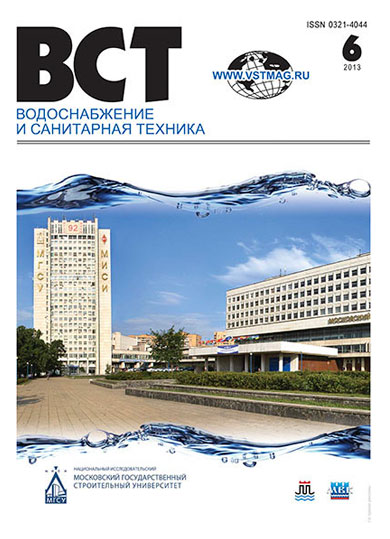
Number 6 / 2013
To download all number in format PDF The further text is accessible on a paid subscription.
For authorisation enter the login/password.
Or subscribe
Number maintenance (pdf) (doc)
Number abstract (doc)
Literature lists to articles (doc)
|
bbk 000000
UDC
Training of high-qualified personnel – the core of the branch development
|
bbk 000000
UDC 628.16.6
Pervov Aleksei, Efremov R. V., Spitsov Dmitrii, Andrianov A. P., Gorbunova T. P.
Membrane methods in drinking water supply: membrane selection, water quality prediction, concentrate utilization
Summary
It is shown that the use of membrane reverse osmosis and nanofiltration units for drinking water treatment is complicated by the presence of large amounts of concentrates subject to the discharge into the sewer. To reduce water use for local needs the technology of concentrate treatment at the additional stage with the use of nanofiltration membranes was developed and tested. The flow of the generated concentrate is less than 1–6% of the total water flow rate whereas the second stage filtrate can be blended with either treated or incoming water depending on the hardness or presence of such pollutants as iron, ammonium, fluorine, arsenic etc. Process flow schemes, mass balance and the composition of incoming water, filtrate and concentrate at different treatment stages are presented.
Key words
filtrate , reverse osmosis , nanofiltration , drinking water supply , membrane method , concentrate utilization
|
bbk 000000
UDC 621.644.01.004.69
Orlov V. А., Averkeyev I. A., Koblova E. V.
Hydraulic component of alternative pipe materials and protective coatings in trenchless renovation of pressure pipelines
Summary
The results of experimental hydraulic studies of trenchless renovation of pressure pipelines with different protective coatings are analyzed. The studies were carried out in the laboratory of the Water Supply Faculty of the Moscow State Civil Engineering University. The cross-plots of specific resistance – diameter of pipelines made of different materials (protective coating) relationship are presented. The solution of the task of evaluating hydraulic compatibility of some pipe materials and protective coatings used in the relative technologies of trenchless renovation is given.
Key words
pressure pipeline , hydraulic resistance , trenchless renovation technology , pipe protective coating
|
bbk 000000
UDC 621.644
Ishmuratov R. R., Stepanov V. D., Orlov V. А.
The experience of applying trenchless spiral wound technology of pipeline rehabilitation at the Moscow projects
Summary
The specific features of the advanced spiral wound technology of trenchless rehabilitation of water and sewage pipelines based on the use of PUF coating that forms a new pipe inside the old one are presented. The operation sequence during the implementation of separate modifications of this technology (with and without filling pipe space) is stated by the example of a 420 mm diameter sewer section rehabilitation. The projects of rehabilitating old municipal and storm water sewers of different diameters and length by using trenchless spiral wound technology are presented.
Key words
pipeline , trenchless technology , spiral wound method , PUF coating , pipe space , cutting thread
|
bbk 000000
UDC 628.32.004.69
Gogina Elena, Salomeyev V. P., Rouzhitskaya O. A., Pobegailo Yu. P., Makisha Nikolai
Methodological approach to planning the upgrade of wastewater treatment facilities
Summary
The results of analyzing the operation of wastewater treatment facilities are presented. The basic provisions that shall be taken into consideration during the upgrade of wastewater treatment facilities are specified. A comprehensive solution of the environmental issues is suggested: upgrade of the entire facilities and not of separate units; introduction of advanced technologies with an account for local conditions and specific features of the facilities operation; designing the facilities according to the regulatory requirements to the effluent discharge.
Key words
treatment facilities , reconstruction , wastewater
|
bbk 000000
UDC 628.33
Alekseyev E. V.
On using «specific flotosorption» index in flotator process design
Summary
An approach to describing the process of extracting pollutants by flotation based on the adsorption mechanism of the interaction of the participating phases is suggested. Basing on these perceptions possible determination of the flotation engineering parameters is shown. The analysis of the typical dynamics of the water treatment process in contact flotation cell models is presented. The recommendations on determining the parameters of the flotation process: flotation cell capacity and supplied gas (air) flow rate are given.
Key words
flotation , adsorption , water treatment , Langmuir isotherm , specific flotosorption
|
bbk 000000
UDC 628.35:661.63
Rouzhitskaya O. A., Gogina Elena, Salomeyev V. P.
Using reinforced medium for the enhancement of phosphate and organics removal from wastewater
Summary
The results of investigating advanced phosphate removal from domestic wastewater are presented. The method of advanced wastewater treatment with the use of reinforced medium is suggested. The highest phosphate removal efficiency is achieved with the help of the technology without activated sludge recycling. The enhancing effect of reinforced medium on biological removal of organics is shown. The activity coefficients of the biological process with the use of reinforced medium are determined.
Key words
wastewater , bioreactor , sludge index , biogenic elements , active sludge dosage , dissolved iron , reinforced medium
|
bbk 000000
UDC 628.34
Fedorovskaya T. G., Koudryashova G. N.
On high alkaline sulfide-containing wastewater treatment
Summary
One of the main problems experienced during tannery wastewater transportation and treatment is hydrogen sulfide release that causes pipeline corrosion, gas contamination of premises and wastewater treatment facilities territory. The methods of sulfide-containing wastewater treatment have been well investigated; however, the reason of hydrogen sulfide release is still urgent and needs explanation. Theoretic and experimental studies carried out at the Moscow State University of Civil Engineering allowed explaining the reasons of hydrogen sulfide release from high alkaline solutions. Experimental studies with standardized test solutions of sodium sulfide showed that their alkalization inhibited hydrogen sulfide release, however required large amounts of alkaline agent and could be hardly adopted for practical use.
Key words
cleansing , wastewater , hydrogen sulfide , tannery , sulfide , high alkaline solution
|
|